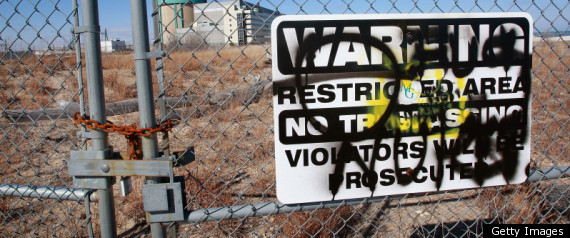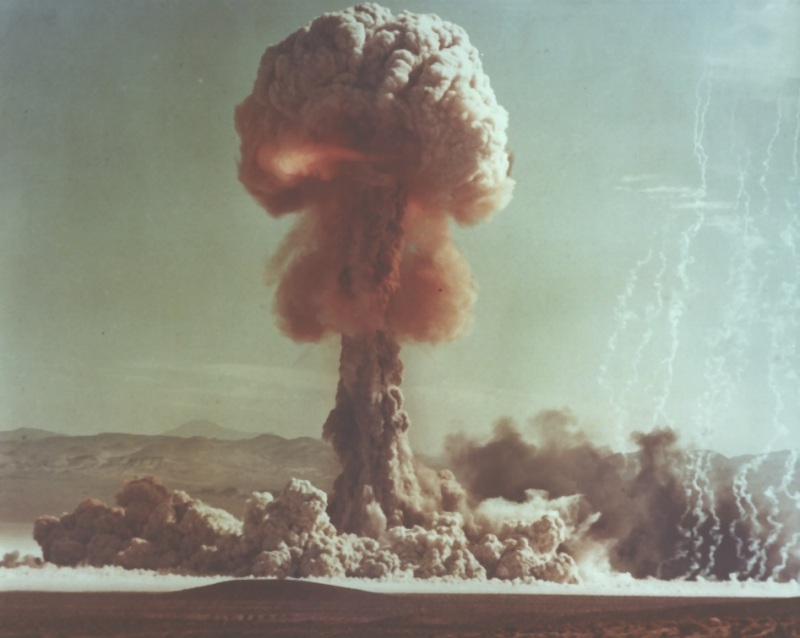Most existing nuclear waste came from production of nuclear weapons. About 77 million gallons of military nuclear waste in liquid form was stored in steel tanks, mostly in South Carolina, Washington and Idaho. In the private sector, 82 nuclear plants operating in 1982 used uranium fuel to produce electricity. Highly radioactive spent fuel rods were stored in pools of water at reactor sites, but many utilities were running out of storage space.
The Nuclear Waste Policy Act of 1982 created a timetable and procedure for establishing a permanent, underground repository for high-level radioactive waste by the mid-1990s, and provided for some temporary federal storage of waste, including spent fuel from civilian nuclear reactors. State governments were authorized to veto a national government decision to place a waste repository within their borders, and the veto would stand unless both houses of Congress voted to override it. The Act also called for developing plans by 1985 to build monitored retrievable storage (MRS) facilities, where wastes could be kept for 50 to 100 years or more and then be removed for permanent disposal or for reprocessing.
Congress assigned responsibility to the U.S. Department of Energy (DOE) to site, construct, operate, and close a repository for the disposal of spent nuclear fuel and high-level radioactive waste. The U.S. Environmental Protection Agency (EPA) was directed to set public health and safety standards for releases of radioactive materials from a repository, and the U.S. Nuclear Regulatory Commission (NRC) was required to promulgate regulations governing construction, operation, and closure of a repository. Generators and owners of spent nuclear fuel and high-level radioactive waste were required to pay the costs of disposal of such radioactive materials. The waste program, which was expected to cost billions of dollars, would be funded through a fee paid by electric utilities on nuclear-generated electricity. An Office of Civilian Radioactive Waste Management was established in the U.S. Department of Energy (DOE) to implement the Act.
The Nuclear waste policy Act required the Secretary of Energy to issue guidelines for selection of sites for construction of two permanent, underground nuclear waste repositories. DOE was to study five potential sites, and then recommend three to the President by January 1, 1985. Five additional sites were to be studied and three of them recommended to the president by July 1, 1989 as possible locations for a second repository. A full environmental impact statement was required for any site recommended to the President.
Locations considered to be leading contenders for a permanent repository were basalt formations at the government's Hanford Nuclear Reservation in Washington; volcanic tuff formations at its Nevada nuclear test site, and several salt formations in Utah, Texas, Louisiana and Mississippi. Salt and granite formations in other states from Maine to Georgia had also been surveyed, but not evaluated in great detail.
The President was required to review site recommendations and submit to Congress by March 31, 1987 his recommendation of one site for the first repository, and by March 31, 1990, his recommendation for a second repository. The amount of high-level waste or spent fuel that could be placed in the first repository was limited to the equivalent of 70,000 metric tons of heavy metal until a second repository was built. The Act required the national government to take ownership of all nuclear waste or spent fuel at the reactor site, transport it to the repository, and thereafter be responsible for its containment.
The Act authorized DOE to provide up to 1,900 metric tons of temporary storage capacity for spent fuel from civilian nuclear reactors. It required that spent fuel in temporary storage facilities be moved to permanent storage within three years after a permanent waste repository went into operation. Costs of temporary storage would be paid by fees collected from electric utilities using the storage.
The Act required the Secretary of Energy to report to Congress by June 1, 1985 on the need for and feasibility of a monitored retrievable storage facility (MRS) and specified that the report was to include five different combinations of proposed sites and facility designs, involving at least three different locations. Environmental assessments were required for the sites. It barred construction of an MRS facility in a state under consideration for a permanent waste repository. The Act required DOE to consult closely throughout the site selection process with states or Indian tribes that might be affected by the location of a waste facility, and allowed a state (governor or legislature) or Indian tribe to veto a federal decision to place within its borders a waste repository or temporary storage facility holding 300 tons or more of spent fuel, but provided that the veto could be overruled by a vote of both houses of Congress. The Act established a Nuclear Waste Fund composed of fees levied against electric utilities to pay for the costs of constructing and operating a permanent repository, and set the fee at one mill per kilowatt-hour of nuclear electricity generated. Utilities were charged a one-time fee for storage of spent fuel created before enactment of the law. Nuclear waste from defense activities was exempted from most provisions of the Act, which required that if military waste were put into a civilian repository, the government would pay its pro rata share of the cost of development, construction and operation of the repository. The Act authorized impact assistance payments to states or Indian tribes to offset any costs resulting from location of a waste facility within their borders.
The Nuclear Waste Policy Act of 1982 created a timetable and procedure for establishing a permanent, underground repository for high-level radioactive waste by the mid-1990s, and provided for some temporary federal storage of waste, including spent fuel from civilian nuclear reactors. State governments were authorized to veto a national government decision to place a waste repository within their borders, and the veto would stand unless both houses of Congress voted to override it. The Act also called for developing plans by 1985 to build monitored retrievable storage (MRS) facilities, where wastes could be kept for 50 to 100 years or more and then be removed for permanent disposal or for reprocessing.
Congress assigned responsibility to the U.S. Department of Energy (DOE) to site, construct, operate, and close a repository for the disposal of spent nuclear fuel and high-level radioactive waste. The U.S. Environmental Protection Agency (EPA) was directed to set public health and safety standards for releases of radioactive materials from a repository, and the U.S. Nuclear Regulatory Commission (NRC) was required to promulgate regulations governing construction, operation, and closure of a repository. Generators and owners of spent nuclear fuel and high-level radioactive waste were required to pay the costs of disposal of such radioactive materials. The waste program, which was expected to cost billions of dollars, would be funded through a fee paid by electric utilities on nuclear-generated electricity. An Office of Civilian Radioactive Waste Management was established in the U.S. Department of Energy (DOE) to implement the Act.
The Nuclear waste policy Act required the Secretary of Energy to issue guidelines for selection of sites for construction of two permanent, underground nuclear waste repositories. DOE was to study five potential sites, and then recommend three to the President by January 1, 1985. Five additional sites were to be studied and three of them recommended to the president by July 1, 1989 as possible locations for a second repository. A full environmental impact statement was required for any site recommended to the President.
 U.S. Nuclear Regulatory |  Yucca Mountain nuclear waste |  dump in Nevada\x26#39;s Yucca | Yucca Mountain Nuclear Waste |  Print. Aerial view of |
 Yucca Mountain nuclear |  cost of nuclear waste disposal |  Yucca Mountain nuclear |  Yucca Mountain nuclear |  The Yucca Mountain Nuclear |
The Act authorized DOE to provide up to 1,900 metric tons of temporary storage capacity for spent fuel from civilian nuclear reactors. It required that spent fuel in temporary storage facilities be moved to permanent storage within three years after a permanent waste repository went into operation. Costs of temporary storage would be paid by fees collected from electric utilities using the storage.
 US nuclear waste dump at |  nuclear waste dump at |  Bid for Nuclear Waste Dump |  Yucca Mountain nuclear |  Yucca Mountain radioactive |
 the nation\x26#39;s first nuclear waste dump at Yucca Mountain in Nevada. |  open a nuclear waste dump |  Hilary Duff Pregnant Photo |  Hilary Duff Is Not Pregnant |  August 29, 2011 Hilary Duff |
No comments:
Post a Comment